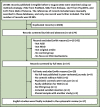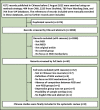Potential mechanisms of non-suicidal self-injury (NSSI) in major depressive disorder: a systematic review
- PMID: 37655114
- PMCID: PMC10465892
- DOI: 10.1136/gpsych-2022-100946
Potential mechanisms of non-suicidal self-injury (NSSI) in major depressive disorder: a systematic review
Abstract
Background: Non-suicidal self-injury (NSSI) is a frequent and prominent phenomenon in major depressive disorder (MDD). Even though its prevalence and risk factors are relatively well understood, the potential mechanisms of NSSI in MDD remain elusive.
Aims: To review present evidence related to the potential mechanisms of NSSI in MDD.
Methods: According to Preferred Reporting Items for Systematic Reviews and Meta-Analyses 2020 guidelines, articles for this systematic review were searched on Medline (through PubMed), Embase (through Elsevier), PsycINFO (through OVID) and Web of Science databases for English articles, as well as China National Knowledge Infrastructure (CNKI), SinoMed, Wanfang Data, and the Chongqing VIP Chinese Science and Technology Periodical (VIP) Databases for Chinese articles published from the date of inception to 2 August 2022. Two researchers (BW, HZ) independently screened studies based on inclusion and exclusion criteria and assessed their quality.
Results: A total of 25 157 studies were searched. Only 25 of them were ultimately included, containing 3336 subjects (1535 patients with MDD and NSSI, 1403 patients with MDD without NSSI and 398 HCs). Included studies were divided into 6 categories: psychosocial factors (11 studies), neuroimaging (8 studies), stress and hypothalamic-pituitary-adrenal (HPA) axis (2 studies), pain perception (1 study), electroencephalogram (EEG) (2 studies) and epigenetics (1 study).
Conclusions: This systematic review indicates that patients with MDD and NSSI might have specific psychosocial factors, aberrant brain functions and neurochemical metabolisms, HPA axis dysfunctions, abnormal pain perceptions and epigenetic alterations.
Keywords: depressive disorder, major; self-injurious behavior.
© Author(s) (or their employer(s)) 2023. Re-use permitted under CC BY-NC. No commercial re-use. See rights and permissions. Published by BMJ.
Conflict of interest statement
Competing interests: None declared.
Figures



Similar articles
-
Risk prediction models for non-suicidal self-injurious behavior in patient with depressive disorder: a protocol for systematic review and mata-analyisis.PLoS One. 2025 Apr 17;20(4):e0321561. doi: 10.1371/journal.pone.0321561. eCollection 2025. PLoS One. 2025. PMID: 40245057 Free PMC article.
-
Global prevalence and characteristics of non-suicidal self-injury between 2010 and 2021 among a non-clinical sample of adolescents: A meta-analysis.Front Psychiatry. 2022 Aug 10;13:912441. doi: 10.3389/fpsyt.2022.912441. eCollection 2022. Front Psychiatry. 2022. PMID: 36032224 Free PMC article.
-
[When is self-injury nonsuicidal? Reviewing the relationship between suicial and nonsuicidal self-injury].Psychiatr Hung. 2020;35(4):476-483. Psychiatr Hung. 2020. PMID: 33263297 Hungarian.
-
Alterations of regional spontaneous neuronal activity and corresponding brain circuits related to non-suicidal self-injury in young adults with major depressive disorder.J Affect Disord. 2022 May 15;305:8-18. doi: 10.1016/j.jad.2022.02.040. Epub 2022 Feb 15. J Affect Disord. 2022. PMID: 35181386
-
Does acupuncture therapy affect peripheral inflammatory cytokines of major depressive disorder? A protocol for the systematic review and meta-analysis.Front Neurol. 2022 Nov 10;13:967965. doi: 10.3389/fneur.2022.967965. eCollection 2022. Front Neurol. 2022. PMID: 36438965 Free PMC article.
Cited by
-
Late-onset major depressive disorder: exploring the therapeutic potential of enhancing cerebral brain-derived neurotrophic factor expression through targeted microRNA delivery.Transl Psychiatry. 2024 Sep 3;14(1):352. doi: 10.1038/s41398-024-02935-7. Transl Psychiatry. 2024. PMID: 39227372 Free PMC article. Review.
-
The sex-specific associations between suicidality and post-traumatic stress disorder in patients with physical injuries.Gen Psychiatr. 2024 Sep 28;37(5):e101520. doi: 10.1136/gpsych-2024-101520. eCollection 2024. Gen Psychiatr. 2024. PMID: 39351257 Free PMC article. No abstract available.
-
Guidelines for the diagnosis and treatment of depressive disorders by integrating Chinese and Western medicine (English edition).Gen Psychiatr. 2025 Feb 10;38(1):e101747. doi: 10.1136/gpsych-2024-101747. eCollection 2025. Gen Psychiatr. 2025. PMID: 39944776 Free PMC article. No abstract available.
-
The Relationship Between Parental Psychological Control and College Students' Non-Suicidal Self-Injury: The Chain Mediation Roles of Relative Deprivation and Depression and the Moderating Role of Peer Relationships.Behav Sci (Basel). 2025 May 24;15(6):729. doi: 10.3390/bs15060729. Behav Sci (Basel). 2025. PMID: 40564511 Free PMC article.
-
Risk prediction models for non-suicidal self-injurious behavior in patient with depressive disorder: a protocol for systematic review and mata-analyisis.PLoS One. 2025 Apr 17;20(4):e0321561. doi: 10.1371/journal.pone.0321561. eCollection 2025. PLoS One. 2025. PMID: 40245057 Free PMC article.
References
-
- American Psychiatric Association . Diagnostic and Statistical Manual of Mental Disorders. 5th edn. Arlington, VA: American Psychiatric Association, 2013. 10.1176/appi.books.9780890425596 - DOI
LinkOut - more resources
Full Text Sources
